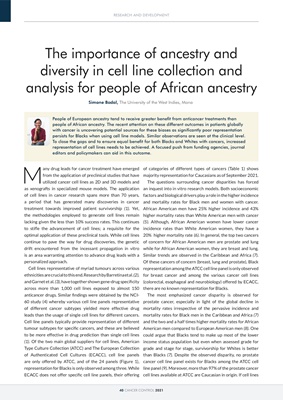
RESEARCH AND DEVELOPMENT
40 CANCER CONTROL 2021
The importance of ancestry and
diversity in cell line collection and
analysis for people of African ancestry
Simone Badal, The University of the West Indies, Mona
M
any drug leads for cancer treatment have emerged
from the application of preclinical studies that have
utilized cancer cell lines as 2D and 3D models and
as xenografts in specialized mouse models. The application
of cell lines in cancer research spans more than 70 years,
a period that has generated many discoveries in cancer
treatment towards improved patient survivorship (1). Yet,
the methodologies employed to generate cell lines remain
lacking given the less than 10% success rates. This continues
to stifle the advancement of cell lines; a requisite for the
optimal application of these preclinical tools. While cell lines
continue to pave the way for drug discoveries, the genetic
drift encountered from the incessant propagation in vitro
is an area warranting attention to advance drug leads with a
personalized approach.
Cell lines representative of myriad tumours across various
ethnicities are crucial to this end. Research by Barretina et al. (2),
and Garnet et al. (3), have together shown gene-drug specificity
across more than 1,000 cell lines exposed to almost 150
anticancer drugs. Similar findings were obtained by the NCI60 study (4) whereby
various cell line panels representative
of different cancer subtypes yielded more effective drug
leads than the usage of single cell lines for different cancers.
Cell line panels typically provide representation of different
tumour subtypes for specific cancers, and these are believed
to be more effective in drug prediction than single cell lines
(1). Of the two main global suppliers for cell lines, American
Type Culture Collection (ATCC) and The European Collection
of Authenticated Cell Cultures (ECACC), cell line panels
are only offered by ATCC, and of the 24 panels (Figure 1),
representation for Blacks is only observed among three. While
ECACC does not offer specific cell line panels, their offering of categories of different types of cancers (Table 1) shows
majority representation for Caucasians as of September 2021.
The questions surrounding cancer disparities has forced
an inquest into in vitro research models. Both socioeconomic
factors and biological drivers play a role in the higher incidence
and mortality rates for Black men and women with cancer.
African American men have 25% higher incidence and 43%
higher mortality rates than White American men with cancer
(5). Although, African American women have lower cancer
incidence rates than White American women, they have a
20% higher mortality rate (6). In general, the top two cancers
of concern for African American men are prostate and lung
while for African American women, they are breast and lung.
Similar trends are observed in the Caribbean and Africa (7).
Of these cancers of concern (breast, lung and prostate), Black
representation among the ATCC cell line panel is only observed
for breast cancer and among the various cancer cell lines
(colorectal, esophageal and neurobiology) offered by ECACC,
there are no known representation for Blacks.
The most emphasized cancer disparity is observed for
prostate cancer, especially in light of the global decline in
mortality rates irrespective of the pervasive incidence and
mortality rates for Black men in the Caribbean and Africa (7)
and the two and a half times higher mortality rates for African
American men compared to European American men (8). One
could argue that Blacks tend to make up most of the lower
income status population but even when assessed grade for
grade and stage for stage, survivorship for Whites is better
than Blacks (7). Despite the observed disparity, no prostate
cancer cell line panel exists for Blacks among the ATCC cell
line panel (9). Moreover, more than 97% of the prostate cancer
cell lines available at ATCC are Caucasian in origin. If cell lines
People of European ancestry tend to receive greater benefit from anticancer treatments than
people of African ancestry. The recent attention on these different outcomes in patients globally
with cancer is uncovering potential sources for these biases as significantly poor representation
persists for Blacks when using cell line models. Similar observations are seen at the clinical level.
To close the gaps and to ensure equal benefit for both Blacks and Whites with cancers, increased
representation of cell lines needs to be achieved. A focused push from funding agencies, journal
editors and policymakers can aid in this outcome.